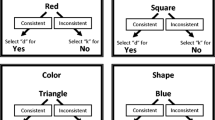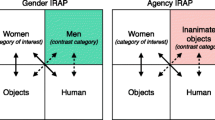Abstract
A recently published article reported a particular pattern of responding that has been observed on the Implicit Relational Assessment Procedure (IRAP), referred to as a Single-Trial-Type-Dominance-Effect (STTDE; Finn, Barnes-Holmes, & McEnteggart in The Psychological Record, 68(1), 11–25, 2018). To account for the phenomenon, the Differential Arbitrarily Applicable Relational Responding Effects (DAARRE) model of IRAP performance was proposed. The DAARRE model predicts the STTDE in terms of an overlap in the functional properties of the label, target, and response-option stimuli presented within an IRAP. This article presents an initial attempt at engineering a STTDE within an experimental session. Forty participants were exposed to a series of training procedures and IRAPs. The training procedures consisted of a series of trials that aimed to establish a “True” function for a picture stimulus that was subsequently presented in the IRAP; participants were then exposed to an IRAP in which participants were required to respond “True” on a specific trial-type that presented that picture. Consistent with the DAARRE model, the STTDE emerged for the predicted trial-type, with analyses at both the group and individual participant level supporting this conclusion. The implications of the findings for future research on analyzing the dynamics of arbitrarily applicable relational responding are discussed.



Similar content being viewed by others
Notes
The word “appropriate(ly)” as used in this sentence simply implies responding in accordance with the prevailing contingencies in the natural environment.
Finn et al. (2018) found that the STTDE appeared to be relatively stronger for participants with extended histories of completing latency-based measures (see General Discussion of Finn et al. for a post-hoc explanation of this moderating variable). To ensure that all participants in the current study had a minimum level of experience with the IRAP, they completed a familiarization IRAP before the experimental manipulation (the stimuli from the familiarization IRAP were never used in subsequent training and testing).
Because the IRAPs that followed each iteration of the function training task presented only two test block-pairs, the D-IRAP scores comprised the average of these two pairs of test blocks. In a small number of cases (N = 11) where participants did not maintain the performance criteria across a test block-pair, a D-IRAP score was produced from one test block-pair. It should be stressed, however, that each participant completed four separate IRAPs, each with two test block-pairs (i.e., eight test block-pairs in total). The effects reported in the current study were thus generated from a minimum of five test block-pairs for each participant. Therefore, the effects reported here are based on more data points than is typical in IRAP research. The data from the first Test IRAP completed by participant 2 were excluded from all analyses due to a translation error in the stimulus set. Participant 2 highlighted the error, and the stimuli were removed from the stimulus pool and were thus not presented to any other participant.
Secondary analyses employing the performance criteria of mean latency of less than 2,000ms and accuracy of greater than 75% are presented in Appendix A.
References
Barnes-Holmes, D., Barnes-Holmes, Y., Stewart, I., & Boles, S. (2010). A sketch of the Implicit Relational Assessment Procedure (IRAP) and the Relational Elaboration and Coherence (REC) model. The Psychological Record, 60, 527–542. https://doi.org/10.1007/BF03395726.
Dodds, P. S., Clark, E. M., Desu, S., Frank, M. R., Reagan, A. J., Williams, J. R., . . . , Megerdoomian, K. (2015). Human language reveals a universal positivity bias. Proceedings of the National Academy of Sciences, 112(8), 2389–2394. doi:https://doi.org/10.1073/pnas.1411678112
Dougher, M. J., Augustson, E., Markham, M. R., Greenway, D. E., & Wulfert, E. (1994). The transfer of respondent eliciting and extinction functions through stimulus equivalence classes. Journal of the Experimental Analysis of Behavior, 62(3), 331–335. https://doi.org/10.1901/jeab.1994.62-331.
Dymond, S., & Barnes, D. (1994). A transfer of self-discrimination response functions through equivalence relations. Journal of the Experimental Analysis of Behavior, 62(2), 251–267. https://doi.org/10.1901/jeab.1994.62-251.
Dymond, S., & Barnes, D. (1995). A transformation of self-discrimination response functions in accordance with the arbitrarily applicable relations of sameness, more than, and less than. Journal of the Experimental Analysis of Behavior, 64(2), 163–184. https://doi.org/10.1901/jeab.1995.64-163.
Epstein, R. (2012). Crying babies. Journal of Contextual Behavioral Science, 1(1–2), 43–48. https://doi.org/10.1016/j.jcbs.2012.05.001.
Finn, M., Barnes-Holmes, D., Hussey, I., & Graddy, J. (2016). Exploring the behavioral dynamics of the implicit relational assessment procedure: The impact of three types of introductory rules. The Psychological Record, 66, 309–321. https://doi.org/10.1007/s40732-016-0173-4.
Finn, M., Barnes-Holmes, D., & McEnteggart, C. (2018). Exploring the single-trial-type-dominance-effect in the IRAP: Developing a differential arbitrarily applicable relational responding effects (DAARRE) model. The Psychological Record, 68(1), 11–25. https://doi.org/10.1007/s40732-017-0262-z.
Hayes, J., Stewart, I., & McElwee, J. (2016). Assessing and training young children in same and different relations using the relational evaluation procedure (REP). The Psychological Record, 66(4), 547–561. https://doi.org/10.1007/s40732-016-0191-2.
Hayes, J., Stewart, I., & McElwee, J. (2017). Children’s answering of yes-no questions: A review of research including particular consideration of the relational evaluation procedure. Behavioral Development Bulletin, 22(1), 173. https://doi.org/10.1037/bdb0000027.
Hayes, S. C., Barnes-Holmes, D., & Roche, B. (2001). Relational Frame Theory: A post-Skinnerian account of human language and cognition. New York, NY: Kluwer Academic.
Kavanagh, D., Barnes-Holmes, Y., Barnes-Holmes, D., McEnteggart, C., & Finn, M. (2018). Exploring differential trial-type effects and the impact of a talk-aloud procedure on deictic relational responding on the IRAP. The Psychological Record., 68(2), 163–176. https://doi.org/10.1007/s40732-018-0276-1.
Keuleers, E., Diependaele, K., & Brysbaert, M. (2010). Practice effects in large-scale visual word recognition studies: A lexical decision study on 14,000 Dutch mono-and disyllabic words and nonwords. Frontiers in Psychology, 1, 174. https://doi.org/10.3389/fpsyg.2010.00174.
Maloney, E., & Barnes-Holmes, D. (2016). Exploring the behavioral dynamics of the Implicit Relational Assessment Procedure: The role of relational contextual cues versus relational coherence indicators as response options. The Psychological Record, 66, 1–9. https://doi.org/10.1007/s40732-016-0180-5.
O'Shea, B., Watson, D. G., & Brown, G. D. (2016). Measuring implicit attitudes: A positive framing bias flaw in the implicit relational assessment procedure (IRAP). Psychological Assessment, 28(2), 158. https://doi.org/10.1037/pas0000172.
Peirce, J. W. (2007). PsychoPy—psychophysics software in Python. Journal of Neuroscience Methods, 162(1–2), 8–13. https://doi.org/10.1016/j.jneumeth.2006.11.017.
Perez, W. F., Fidalgo, A. P., Kovac, R., & Nico, Y. C. (2015). The transfer of Cfunc contextual control through equivalence relations. Journal of the Experimental Analysis of Behavior, 103(3), 511–523. https://doi.org/10.1002/jeab.150.
Perez, W. F., Kovac, R., Nico, Y. C., Caro, D. M., Fidalgo, A. P., Linares, I., de Almeida, J. H., & de Rose, J. C. (2017). The transfer of Crel contextual control (same, opposite, less than, more than) through equivalence relations. Journal of the Experimental Analysis of Behavior, 108(3), 318–334. https://doi.org/10.1002/jeab.284.
Proctor, R. W., & Cho, Y. S. (2006). Polarity correspondence: a general principle for performance of speeded binary classification tasks. Psychological Bulletin, 132(3), 416. https://doi.org/10.1037/0033-2909.132.3.416.
Rothermund, K., & Wentura, D. (2004). Underlying processes in the implicit association test: dissociating salience from associations. Journal of Experimental Psychology: General, 133(2), 139. https://doi.org/10.1037/0096-3445.133.2.139.
Sidman, M. (1971). Reading and auditory-visual equivalences. Journal of Speech, Language, & Hearing Research, 14(1), 5–13. https://doi.org/10.1044/jshr.1401.05.
Sidman, M. (1994). Stimulus equivalence: A research story. Boston, MA: Authors Cooperative.
Sidman, M., Rauzin, R., Lazar, R., Cunningham, S., Tailby, W., & Carrigan, P. (1982). A search for symmetry in the conditional discriminations of rhesus monkeys, baboons, and children. Journal of the Experimental Analysis of Behavior, 37(1), 23–44. https://doi.org/10.1901/jeab.1982.37-23.
Vahey, N. A., Nicholson, E., & Barnes-Holmes, D. (2015). A meta-analysis of criterion effects for the implicit relational assessment procedure (IRAP) in the clinical domain. Journal of Behavior Therapy and Experimental Psychiatry, 48, 59–65. https://doi.org/10.1016/j.jbtep.2015.01.004.
Acknowledgements
The data for the current manuscript was collected and prepared with the support of the FWO Type I Odysseus Programme at Ghent University, Belgium.
Author information
Authors and Affiliations
Corresponding author
Ethics declarations
Conflict of Interest
On behalf of all authors, the corresponding author states that there is no conflict of interest.
Ethical Approval
All procedures performed in studies involving human participants were in accordance with the ethical standards of the institutional research committee and with the 1964 Helsinki declaration and its later amendments or comparable ethical standards.
Informed Consent
Informed consent was obtained from all individual participants included in the study.
Additional information
Publisher’s Note
Springer Nature remains neutral with regard to jurisdictional claims in published maps and institutional affiliations.
Electronic supplementary material
ESM 1
(DOCX 39.0 kb)
Rights and permissions
About this article
Cite this article
Finn, M., Barnes-Holmes, D., McEnteggart, C. et al. Predicting and Influencing the Single-Trial-Type-Dominance-Effect: the First Study. Psychol Rec 69, 425–435 (2019). https://doi.org/10.1007/s40732-019-00347-4
Published:
Issue Date:
DOI: https://doi.org/10.1007/s40732-019-00347-4




